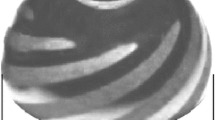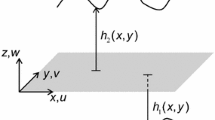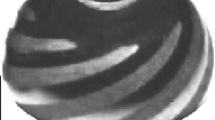Abstract
The theory of a spiral bearing with a quasi-incompressible lubricant, proposed by Whipple [1], and expanded in [2–4], deviates from experimental investigations, particularly with large values of the compressibility parameter and intermediate values of the Knudsen numbers. Investigations carried out in simplified models of a spiral bearing [6, 7] have shown that the compressibility of a gas layer lowers its bearing capacity. This effect manifests itself even more strongly with intermediate values of the Knudsen number. Therefore, attempts to take account of the effect of slip within the framework of the theory of a quasi-incompressible layer [8] do not achieve their purpose. The proposed theory of a spiral bearing takes account of the combined influence of both effects, and is in agreement with experiment.
Similar content being viewed by others
Literature cited
R. T. P. Whipple, “The inclined groove bearing,” AERE Rept t/R 622 (revised), United Kingdom Atomic Energy Authority. Res. Group, Atomic Energy Res. Establishment, Harwell, Berkshire (1958).
S. B. Malanoski and C. H. T. Pan, “The static and dynamic characteristics of the spiral-grooved thrust bearing,” Trans ASME, Ser. D, J. Basic Engng.,87, No. 3 (1965).
A. G. Burgvits and A. V. Emel'yanov, “Determination of the bearing capacity of a gas thrust bearing with spiral grooves of longitudinal transverse profile,” Mashinovedenie, No. 4 (1967).
A. V. Emel'yanov and L. S. Emel'yanova, “Optimal parameters and comparative characteristics of gas thrust bearings with spiral grooves of different transverse profiles,” in: Gas Lubricants for Bearings [in Russian], Moscow (1968).
P. Steranka, “Theoretical-experimental correlation in the 16. PIGA gas spin bearing,” M. I. T. Instrumentation Laboratory Rept. E-2132 (1967).
M. Wildmann, “On the behavior of grooved plate thrust bearings with a compressible lubricant,” Trans. ASME, Ser. F, No. 4 (1968).
V. N. Constantinescu and V. Castelli, “On the local compressibility effect in spiral-groove bearings,” Trans. ASME, Ser. F, J. Lubrication Technology,91, No. 1 (1969).
F. C. Hsing and S. B. Malanoski, “Mean free path effect in spiral-grooved thrust bearings,” Trans. ASME, Ser. F, J. Lubrication Technology,91, No. 1 (1969).
A. Burgdorfer, “The influence of the molecular mean free path on the performance of hydrodynmic gas-lubricated bearings,” Trans. ASME, Ser. D, J. Basic Engng.,80, No. 1 (1959).
Author information
Authors and Affiliations
Additional information
Translated from Izvestiya Akademii Nauk SSSR, Mekhanika Zhidkosti i Gaza, No. 5, pp. 84–93, September–October, 1971.
The authors thank V. Idel'son, who carried out the required calculations at the Computational Center of the Siberian Branch of the Academy of Sciences of the USSR.
Rights and permissions
About this article
Cite this article
Emel'yanov, A.V., Emel'yanova, L.S. Theory of a gas bearing with spiral grooves, taking account of the effects of slip and of local compressibility. Fluid Dyn 6, 799–807 (1971). https://doi.org/10.1007/BF01013863
Received:
Issue Date:
DOI: https://doi.org/10.1007/BF01013863




